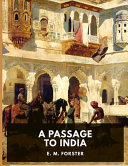Estimated read time: 5 min read
One Sentence Summary
"A Passage to India" explores the complex relationships between the British colonizers and the Indian people in the backdrop of cultural misunderstandings and personal conflicts.
Table of Contents
Introduction
"A Passage to India" is a novel by E.M. Forster, first published in 1924. The novel is set against the backdrop of British colonialism in India during the early 20th century. It explores themes of friendship, cultural misunderstandings, and the tension between the colonizers and the colonized. The story delves into the complexities of human relationships and the impact of colonialism on both the British and Indian characters.
Brief Synopsis
Plot Overview
The novel is set in the fictional city of Chandrapore, India, and follows the experiences of various characters as they navigate the cultural, racial, and political tensions of the time. The story begins with Dr. Aziz, a young Indian Muslim doctor, befriending two Englishwomen, Adela Quested and Mrs. Moore. The women are visiting India and seek to explore the "real" India beyond the confines of British colonial society.
Setting
The setting of the novel is crucial to the story, as it takes place in India during the period of British colonial rule. The stark contrast between the British ruling class and the Indian population forms the backdrop against which the characters' interactions unfold. The fictional city of Chandrapore serves as a microcosm of the larger tensions between the colonizers and the colonized.
Main Characters
The novel features a diverse cast of characters, each representing different facets of the colonial experience.
| Character | Description |
|---|---|
| Dr. Aziz | A young Indian Muslim doctor who becomes embroiled in a controversy with the British authorities. |
| Adela Quested | An Englishwoman who visits India with the intention of understanding the country and its people. |
| Mrs. Moore | Adela's elderly companion, who forms a deep connection with the Indian culture and people. |
| Cyril Fielding | The principal of the Government College in Chandrapore, who forms friendships with both Indians and English. |
| Ronny Heaslop | A British city magistrate in Chandrapore and Adela's fiancé. He represents the colonial authority and its prejudices. |
Summary of Different Story Points Over Chapters
Chapter 1-5
The novel opens with the introduction of Dr. Aziz, who meets Adela Quested and Mrs. Moore. They form a bond, and Aziz invites them to visit the Marabar Caves. The initial chapters establish the characters and the cultural dynamics between the Indians and the British.
Chapter 6-10
Adela and Mrs. Moore's visit to the Marabar Caves leads to a significant event that sets off a chain of misunderstandings and accusations, deeply affecting the relationships between the Indian and British characters.
Chapter 11-15
The tension escalates as the fallout from the Marabar incident unfolds. Accusations and prejudices come to the forefront, straining the already fragile relations between the British and the Indians. The legal and social implications of the incident come to the fore.
Chapter 16-20
The trial of Dr. Aziz becomes the focal point of the narrative, revealing the deep-rooted biases and injustices within the colonial system. The trial serves as a catalyst for the characters to confront their own prejudices and misconceptions.
Chapter 21-25
The aftermath of the trial brings about a reckoning for the characters, forcing them to confront the realities of colonialism and its impact on their lives. The novel concludes with a sense of unresolved tensions and the lasting implications of the events on the characters.
Main Events
The central events in the novel revolve around the visit to the Marabar Caves and the subsequent trial of Dr. Aziz. These events serve as a catalyst for exploring the themes of cultural misunderstanding, prejudice, and the power dynamics inherent in colonial relationships.
Themes and Insights
Cultural Divide
The novel delves into the deep cultural and racial divides between the British colonizers and the Indian population. It highlights the misunderstandings and misconceptions that arise from these stark cultural differences.
Power and Prejudice
The power dynamics and prejudices inherent in colonialism are central themes in the novel. It explores how these dynamics shape the interactions and relationships between the British and Indian characters.
Quest for Understanding
The characters' quest for understanding, both of themselves and of the "other," forms a significant theme. The novel portrays the complexities and challenges of seeking genuine understanding across cultural and racial boundaries.
Impact of Colonialism
The novel provides insights into the far-reaching impact of colonialism on both the colonizers and the colonized. It sheds light on the psychological, social, and emotional toll of living under the colonial system.
Reader's Takeaway
"A Passage to India" offers readers a profound exploration of the complexities of human relationships and the enduring impact of colonialism. It prompts reflection on cultural understanding, power dynamics, and the consequences of prejudice. The novel's rich and nuanced characters offer valuable insights into the intricacies of colonial societies and their lasting legacies.
Conclusion
In conclusion, "A Passage to India" stands as a timeless exploration of the human experience within the context of colonial India. E.M. Forster's masterful storytelling and keen observations provide readers with a compelling narrative that resonates with themes of cultural divide, power, prejudice, and the quest for understanding. The novel's enduring relevance lies in its ability to prompt introspection and critical examination of the complexities of colonial history and its impact on individuals and societies.
A Passage to India FAQ
What is the setting of 'A Passage to India'?
The novel is set in British-ruled India in the 1920s, primarily in the fictional city of Chandrapore.
What is the main theme of 'A Passage to India'?
The main themes include the clash of cultures, the nature of friendship, the difficulty of connection, and the limitations of understanding.
Who are the main characters in 'A Passage to India'?
The main characters include Dr. Aziz, Adela Quested, Cyril Fielding, and Mrs. Moore.
What is the central conflict in the novel?
The central conflict revolves around the accusation of an Indian doctor, Dr. Aziz, for an alleged assault on an Englishwoman, Adela Quested, and the ensuing trial.
What is the significance of the Marabar Caves in the story?
The Marabar Caves represent the mysterious and disorienting aspects of India, and they play a significant role in the novel's themes of truth, illusion, and the difficulty of understanding.





